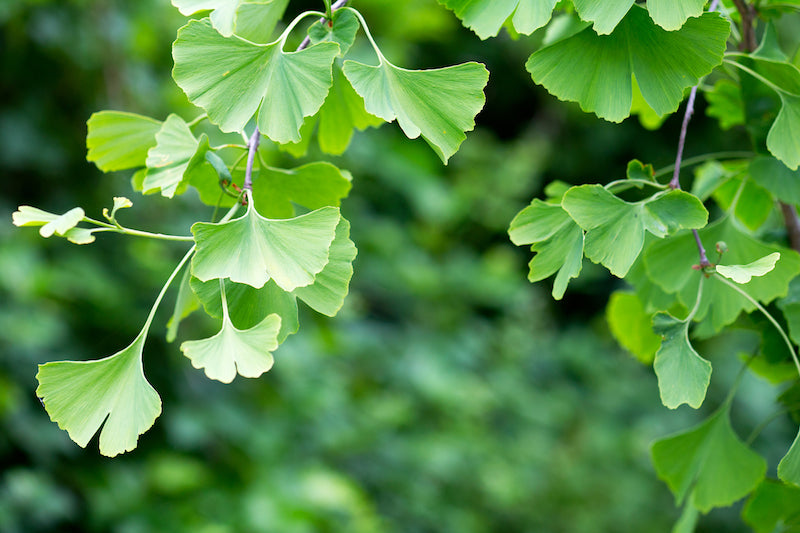The Ginkgo tree is native to eastern Asia, and is no longer considered to be found in the wild.4,5 However, it is found in northern China on the border of Anhui and Zhejiang, and in Guizhou, where it has been said that the last remaining wild Ginkgo trees are relics that were cultivated by ancient Buddhist monks, who grew them around their temples.4,5 It is cultivated commercially in the United States and France, as well as in China for food and herbalism, while frequently grown in and around Chinese temples.3,5 Ginkgo is grown in Australia, southeast Asia, Europe, Japan and the United States as an ornamental shade tree.6
The genus name of Ginkgo is derived from the Japanese pronunciation of yin-kuo, meaning “silver apricot.”4 Whereas its species name, biloba, reflects the leaves’ two lobes.4
Ginkgo is currently the only plant left in the botanical family Ginkgoaceae, as all other related plants of this species that were once abundant, are now extinct.5 The tree is considered a “living fossil” as its morphology has remained relatively unchanged for the last 200 million years, maybe more and can live up to 4,000 years.3,4,5 The tree has unpredictable and slow growth that is less than 30 cm per year on average, which occurs in May through August.5 It can take up to 35 years of growth from seed for a female tree to bear fruit.5
It is dioecious with male flowers growing on one tree, while female seeds develop on another after being pollinated.5 Pollination occurs by wind with one male plant fertilizing up to five female plants.5 The tree is not self-fertile, so both male and female plants need to be located close to one another, or branches of the opposite sex grafted onto the other.5 After hot summers or when grown in sunny locales, flowering and fruiting is more consistent.5 The immature plants can be distinguished by their branches and leaves.5 Female plants have nearly horizontal branches and fan-shape leaves with two distinct, deep lobes. Male plants have angled branches and fan-shape leaves that are not as deeply lobed.5
Planting can be done in any type of well-drained soil or pH, but the tree prefers sun and shelter from strong winds.5 The trees are commonly used in ornamental plantings and can even be espalier pruned to train them to grow on walls.5 Ginkgo can tolerate drought, air pollution and compacted soil, making it ideal for lining city streets, although only male trees are usually planted.5 The female fruits have an unpleasant smell (some liken it to rancid butter) from the butanoic acid content.5 Harvesting leaves from an urban tree is not recommended because Ginkgo can remove air pollutants.4 When transplanting an immature Ginkgo, do so in the spring and offer cold protection if it is the first winter outdoors.5
In western herbalism, the green leaves are harvested just before turning yellow in the fall.4,5 The unique leaves contain the constituents ginkgolides, which have not been discovered in any other plant species.5 Younger tree leaves have been shown to be higher in desirable phytochemicals than older growth.4
The tree’s wood is soft and light with insect repellent abilities and is used for firewood.5 The inconspicuous flowers bloom during the spring season from April to May, while the tree’s seeds ripen in the fall, from October to November.5
Its seeds are edible when cooked and are traditionally eaten as a snack, in desserts or soups and porridges in Asian cultures.5 The fruits are gathered, seeds separated and shelled, then cooked (roasted or boiled) and eaten. Called a “Ginkgo nut,” it tastes slightly like a pine nut or a cross between a potato and sweet chestnut.5 The seed produces an oil that is edible and is also used as a lighting fuel.5 Mixing the fruit pulp with oil or wine creates a soap substitute.5
Traditional Chinese Herbalism commonly uses the seed (instead of the leaf as in Traditional Western Herbalism).5 The plant’s first recorded use was in the historical Chinese herb text, Shen Nung Ben Cao, as well as the 14th century texts, Shi Wu Ben Cao by Lu Dong Yuan and Jih Jung Ben Cao by Wu Jui. However, the use of the leaf was recorded in a few herbal texts dating back to 15th and 16th century China.4 The plant did not come to Europe and the United States until the 16th century and was used in landscaping.4 Research on the plant began in the 1800s, however use as an herb became more regular starting in the mid 1960s.4































